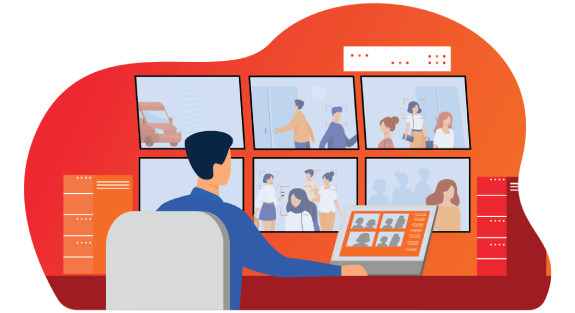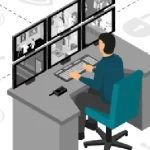It’s a well known fact that thefts or robberies incurred by banks can have a considerable impact on its customers and its business. Such incidences also impact their employees because they are directly in line of fire when such incidences happen.
It is true that in recent years, banks have deployed multiple safety barriers to curtail such crimes. With the increase in the number of ATMs, banks now don’t necessarily need to keep large amounts of cash, but this makes ATMs the biggest target for vandalism. Additionally, digital transactions have increased but they are vulnerable to cyber attacks.
Let’s go through the various challenges that banks face:
- Cybersecurity: As banking transactions move increasingly online, banks face new cybersecurity challenges and risks as criminals develop more sophisticated methods of gaining unauthorized access to customer data.
- Physical Theft: Theft/Burglaries still pose a risk to banks, and institutions must invest in security measures to protect their branches and people.
- Money Laundering: Banks must remain vigilant in preventing criminals from using them to launder money, and must adhere to strict regulatory guidelines to prevent it from happening.
- Fraud: Banks must also be aware of potential fraud, such as identity theft, and must establish measures to protect their customers from it.
- Counterfeit Money: Banks must ensure that counterfeit money does not enter their cash reserves and be circulated throughout the system.
Rise of AI, ML and Digitalization:
Growing threats have compelled banks to harness the latest digital technologies to safeguard human lives, assets and information.
AI-based video surveillance systems are becoming increasingly essential in banking. Video surveillance systems for banks help to predict and deter criminal activities before they take place. Additionally, these video systems can accumulate data from their images and process that data in order to generate fruitful information that is easy to comprehend for everyone in the bank. This helps those in different positions to arrive at judicious decisions more quickly.
IOT-enabled security systems for banks allows them to leverage video surveillance to provide an extra layer of safety and security for their customers and employees. Video surveillance can deter crime, enabling banks to keep a closer watch over their premises and customers and respond to any suspicious activity. Bank surveillance systems can also help to monitor traffic within the bank, enabling them to identify and address any potential threats quickly and effectively. It can also be used to analyze customer behavior, providing valuable insights into customer needs, preferences, and engagement. This helps banks improve customer experience, develop marketing strategies, and increase security.
Video surveillance can also be used to monitor employees and ensure that proper protocol is followed. Additionally, banks can use video surveillance to maintain the accuracy of financial transactions, as well as detect any unauthorized access or suspicious activity.
Here’s a list of few steps that banks can follow to secure their assets, employees, data and information:
- Implement a video surveillance system for banks: Bank video surveillance systems with central monitoring executives can ensure round-the-clock security as they use various softwares to detect and deter suspicious incidences and transactions. These systems can identify transactions that are inconsistent with previous activity, as well as those involving high-risk customers or entities.
- Establish benchmarking and peer comparison: Banks can compare their own financial activity against a set of industry benchmarks. This helps them to identify areas where they may need to increase their security and address any potential risks.
- Implement financial transaction controls: Banks should use a variety of controls to ensure that all financial transactions are properly authorized and monitored. These can include authentication and encryption measures, as well as global sanctions screening and suspicious activity monitoring.
- Integrate risk management into business operations: Banks should ensure that risk management and e-surveillance strategies are embedded in all business operations. This will help identify and mitigate any potential security threats in a timely manner.
- Perform regular risk assessments: Banks should conduct regular risk assessments to ensure that their systems and processes are up to date and compliant with the latest regulations and best practices.
Benefits of video surveillance and analytics for banks:
- Increased Security: Video surveillance systems are a great deterrent to any kind of malicious activity and can be used to protect customers, employees and the bank’s reputation. Video analytics can detect unusual behavior or patterns that may indicate a robbery or other illicit activity.
- Improved Customer Service: Video surveillance can be used to monitor customer activity within the bank. This can improve customer service by allowing staff to quickly identify customer needs and alert staff to any suspicious activity.
- Fraud Detection: Video surveillance can be used to detect fraud in terms of employees and customers. Video analytics can detect unusual transactions, suspicious behavior, and other fraud indicators.
- Enhanced Compliance Monitoring: With the help of video surveillance, banks can monitor and ensure compliance with regulations and internal policies. This will help reduce risks and ensure a safe and secure environment for customers and staff.
- Improved Efficiency: Video surveillance and analytics can be used to improve operational efficiency by monitoring the performance of staff and eliminating any bottlenecks that may occur.
- Cost Savings: Implementing video surveillance and analytics can help banks reduce costs by reducing the need for manual monitoring and labor costs.
Contact Us for end-to-end security solutions:



